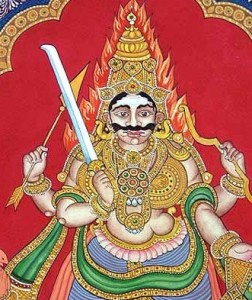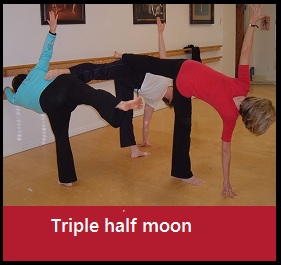In the world of Gods things can happen almost instantly including the actions of Gods, sometimes not well thought out. Virabhadra is a great warrior who rose out of the ground from a lock of hair of the God Shiva. He is fearsome. He has a thousand heads, a thousand eyes, a thousand feet, carries a thousand clubs all in the apparel of a tiger skin.
When Virabhadra rises from the ground he is in the position of Warrior 1, palms together and face upturned. When he draws his sword he is now Warrior 2 and when he reaches forward to pick up the head he has chopped off he is in warrior 3. Of course in the end all is made well and all things are restored, including the head.
Often at times in our lives we need to live like a warrior dealing with hard things that come into our lives. How do we do this fearlessly and keep our head? To be a warrior of courage it means to make thoughtful choices that call us to act rather than react. Strength as a spiritual warrior comes in many ways including showing compassion, exercising self discipline, battling self-ignorance and doing the right thing for the right reason.
There are many versions of this particular story, and here is a melding of several for you to enjoy. If you can enjoy a violent tale like this one!
Vira bhadra stands for a blessed hero friend. Virabhadra was created from a lock of Shiva’s head in a moment of grief, rage and impulsive action. Like other warriors, Virabhadra didn’t think about what his duties were, or the purpose, or whether it was morally right or wrong. All of that was for his commander and Lord to worry about. Shiva is the God of Destruction and one of the many supreme Lord’s of the universe in Hindu mythology. I’m not sure how there can be more than one, but there is. It was Virabhadra’s task to crash a yagna or religious ritual fire and do away with Daksha. Virabhadra did just that. He rose up thru the ground with his two swords representing Warrior 1 and sliced off Daksha’s head – representing warriors 2 and 3.
Why was Shiva so enraged that he impulsively created such a deadly display at a religious service? Daksha was actually Shiva’s father in law, but not accepted by him in the least. Sati was Daksha’s daughter and married to Shiva against her father’s wishes. She attends this yagna event without Shiva who was not invited even tho many other great sages and priest were invited. She has a bit of a public argument with Daksha and becomes so upset and humiliated and saddened that she cannot convince her Father to accept her marriage to Shiva that she fully intends to divorce herself from her family ties. She steps into the fire and is promptly done away with in the ashes. So I guess both Shiva and Sati have impulsive natures that bring about a swift reaction from others.
Shiva feels a “tremor in the force” and realized that his beloved Sati has left mortal existence. This is where his hot impulsive temper and grief takes over and he tears a dreadlock from his head and throws it to the ground. This is from where Virabhadra is created to do the work of Shiva.
So Virabhadra crashes the party, kills Daksha and is ready to destroy all the rest of the guests at the yagna when Sati from the spiritual realm realizes what a disaster this is becoming. Now all the characters in this story start repenting and realizing the terrible turn their impulsive actions have caused.
Sati reenters a physical body and scolds Shiva who is still up in his mountain retreat. She asks him if that is any way to get her Father’s approval by slicing off his head. Shiva appears at the ritual fire and calls off his loyal warrior Virabhadra before more guests are killed. Shiva realizes his mistake and that it wasn’t very wise at all. He puts a goat’s head on Daksha’s body and it is restored to life. I guess Daksha doesn’t mind the goat’s head and he is more humble and compassionate now too. He gives his blessing and support to the marriage, and duly worships Lord Shiva.
What we learn as we contemplate Warrior poses is that we must constantly fight against our impulsive, reactive, unthinking actions. Words and actions that just tumble out in a fit of rage or frustration rarely lead to good outcomes, and sometimes we cannot put back the damage we have done as easily as Sati and Shiva. Be strong, but compassionate and wise. Then the strength of the warrior is in the service of Ahimsa, and Satya. Non-violence and truth.
Photo from here



